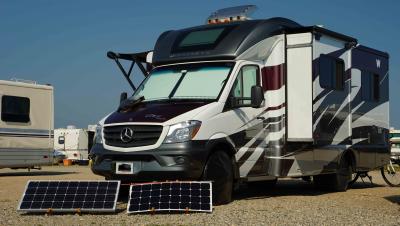My Low-Cost RV Solar Install
I just got back from eight days of dry camping and got lots of comments and questions from people about my RV solar setup. I installed the system last year and wrote a blog post about my DIY Solar Install. It was something that I researched, designed, and installed myself. I added a second 100W flexible panel this spring and have used the full setup a few times this summer. Thought I'd do an update on how it's all working.
As a "sometime" RVer, most of my overnight RV stays happen at establish campgrounds. I'll boondock at trucks stops and camp Wal-Mart when on the road for quick overnight stays. And, I do a little bit of stay put dry camping in the summer -- usually at music festivals or beach/lake-side camping. So, my needs for off-the grid power tend to happen infrequently. This is one of the reasons I decided to go with a portable solar setup. Something I could use when I wanted and needed. I wanted it to be low-cost. I also wanted to have something I could take with me when I trade RVs. So, my install is pretty simple, small, and inexpensive.
My electrical needs are also small. My 25-foot Winnebago View is pretty efficient with all LED lights and DC radios and TVs. My basic needs for power are for lights, monitors, and the water pump. (my frig runs on propane, AC, and DC). The biggest draw I tend to have is for charging battery operated electronic gadgets (phones, laptop, cameras). I have a 1,000-watt inverter (that powers half the coach outlets) which I use mostly for charging this stuff. I have two 12-volt group 24 wet cell batteries in my RV (they came with the RV) which gives me about 170 amp-hours of electricity. There are probably better battery setups, but these work for me.
Here's a link to a vlog that I did on my solar setup:
I'm very pleased with the setup. With the two 100W panels, I can avoid having to run the generator to charge my batteries. I camped for a week at a festival this summer and didn't use the generator at all. Just two weeks ago, I dry camped for eight days and only ran the generator two to three times for short bursts when I needed to use the microwave (luckily I didn't need to use the A/C). The solar panels kept my batteries fully charged each day. I did all my electronic charging during the day, watched a little TV, and listened to my satellite radio every morning.
The portable setup is pretty quick to put in place. It takes about five to seven minutes to hook everything up. The downside is that I have to unhook it all and put it away if I move the rig. With the portable set up, I get pretty good efficiency being able to move and tilt the panels towards the sun. They even work good on cloudy days putting out 2 to 3 amps.
The two panels can fit in my storage compartment under the right rear bed. The rigid panel is a tight fit and I only carry it when I know I'm going to do some stay put dry camping. I really like the flexible panel for weight and ease of storage. It only weighs 4 lbs vs 16 lbs for the rigid glass panel. I carry it with me on all trips just in case I stay as a stop that doesn't have electricity or allow generators. I've read that Renogy has put a temporary hold on selling the flexible panels due to some reported problems with the panels. You can read about one persons experience here Winnie Views RV Updates. I've had no problems with my panel so far.
As I said above, I like my setup and it works just fine for me. Total cost was about $600. Considerably less than having a professional company do a permanent install on my roof. The list of materials and suppliers is listed in my prior post (DIY Solar Install). So far, I've been pleased with the Renogy panels.
The portable install was easy for me to do because I'm familiar with wiring and working with electricity. When I have it setup (i.e., on display) I get lots of comments and curious people stop by asking me how it all works. Hopefully this write-up and vlog will help some others.
Let me know if you have any questions. You can follow more of my journeys at: http://jdawgjourneys.com
Disclaimer: I received no compensation from any of the suppliers or manufacturers of the equipment that are discussed in the article or video. I purchased or made all of the equipment discussed in the article and video. I make no warranty or claims as to how this equipment will work, only that it works for me.






4 Comments
Recommended Comments
Please sign in to comment
You will be able to leave a comment after signing in
Sign In Now